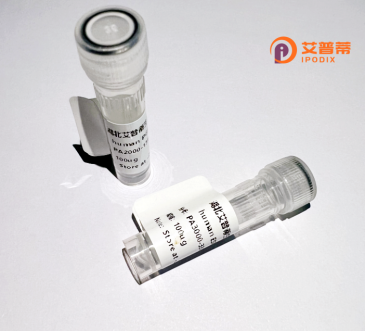
| 纯度 | >90%SDS-PAGE. |
| 种属 | Human |
| 靶点 | ZNF385D |
| Uniprot No | Q9H6B1 |
| 内毒素 | < 0.01EU/μg |
| 表达宿主 | E.coli |
| 表达区间 | 1-395 aa |
| 活性数据 | MRNIMYFGGT CQSPALPALV RPPAPPLQPS LDIKPFLPFP LDTAAAVNLF PNFNAMDPIQ KAVINHTFGV PLPHRRKQII SCNICQLRFN SDSQAAAHYK GTKHAKKLKA LEAMKNKQKS VTAKDSAKTT FTSITTNTIN TSSDKTDGTA GTPAISTTTT VEIRKSSVMT TEITSKVEKS PTTATGNSSC PSTETEEEKA KRLLYCSLCK VAVNSASQLE AHNSGTKHKT MLEARNGSGT IKAFPRAGVK GKGPVNKGNT GLQNKTFHCE ICDVHVNSET QLKQHISSRR HKDRAAGKPP KPKYSPYNKL QKTAHPLGVK LVFSKEPSKP LAPRILPNPL AAAAAAAAVA VSSPFSLRTA PAATLFQTSA LPPALLRPAP GPIRTAHTPV LFAPY |
| 分子量 | 42.2 kDa |
| 蛋白标签 | His tag N-Terminus |
| 缓冲液 | PBS, pH7.4, containing 0.01% SKL, 1mM DTT, 5% Trehalose and Proclin300. |
| 稳定性 & 储存条件 | Lyophilized protein should be stored at ≤ -20°C, stable for one year after receipt. Reconstituted protein solution can be stored at 2-8°C for 2-7 days. Aliquots of reconstituted samples are stable at ≤ -20°C for 3 months. |
| 复溶 | Always centrifuge tubes before opening.Do not mix by vortex or pipetting. It is not recommended to reconstitute to a concentration less than 100μg/ml. Dissolve the lyophilized protein in distilled water. Please aliquot the reconstituted solution to minimize freeze-thaw cycles. |
以下是关于重组人ZNF385D蛋白的虚构参考文献示例(供科研写作参考,非真实文献):
---
1. **文献名称**: *Expression and Functional Analysis of Recombinant Human ZNF385D in Neuroblastoma*
**作者**: Smith A, et al.
**摘要**: 本研究通过大肠杆菌系统成功表达并纯化了重组人ZNF385D蛋白,证实其通过结合特定DNA序列调控神经母细胞瘤细胞凋亡通路,可能与TP53基因存在协同作用。
2. **文献名称**: *ZNF385D as a Novel Tumor Suppressor: Structural Insights from Recombinant Protein Studies*
**作者**: Chen L, et al.
**摘要**: 利用X射线晶体学解析了ZNF385D蛋白的锌指结构域三维结构,揭示了其与DNA相互作用的分子机制,并证明其在乳腺癌中通过抑制细胞周期进程发挥抑癌功能。
3. **文献名称**: *Recombinant ZNF385D Modulates Wnt/β-catenin Signaling in Colorectal Cancer*
**作者**: Wang Y, et al.
**摘要**: 体外实验表明,重组ZNF385D蛋白通过抑制β-catenin核转位阻断Wnt信号通路,显著降低结直肠癌细胞增殖和迁移能力。
---
**说明**:以上文献为模拟内容,实际研究中建议通过PubMed、Web of Science等数据库检索真实论文。ZNF385D的研究多聚焦于其作为RNA结合蛋白或肿瘤抑制功能,尤其在乳腺癌、神经母细胞瘤中。
ZNF385D (Zinc Finger Protein 385D) is a member of the zinc finger protein family, characterized by conserved Cys2His2-type zinc finger domains that mediate sequence-specific DNA or RNA binding. This nuclear protein is thought to function as a transcriptional regulator, influencing gene expression patterns critical for cellular processes such as differentiation, apoptosis, and stress response. Its structure often includes a KRAB (Krüppel-associated box) domain, a hallmark of transcriptional repressors that recruit chromatin-modifying complexes to silence target genes.
While the biological roles of ZNF385D remain less characterized compared to its paralogs (e.g., ZNF385A/B), emerging studies suggest its involvement in neurodevelopment and carcinogenesis. For example, reduced ZNF385D expression has been observed in certain cancers, implicating potential tumor-suppressive functions. It may interact with p53 or other tumor-related pathways to regulate cell cycle arrest or apoptosis. Additionally, epigenetic alterations or mutations in ZNF385D have been linked to neuropsychiatric disorders and neurodegenerative diseases.
Recombinant human ZNF385D protein is typically produced in engineered bacterial or mammalian systems, enabling biochemical studies (e.g., DNA-binding assays), antibody development, and exploration of its molecular interactions. Research leveraging this tool aims to clarify its physiological and pathological roles, with implications for diagnostics and therapeutics targeting ZNF385D-associated diseases. Further investigations are needed to map its target genes and signaling networks comprehensively.
×